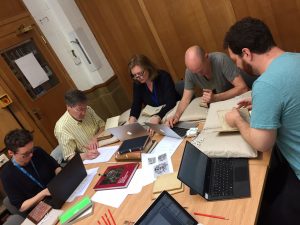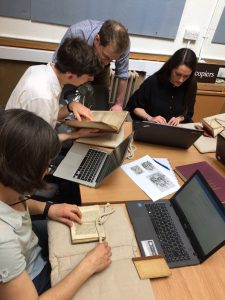Some pictures, belatedly, from the 1st CMT/CUL Catalogathon, a gathering of volunteer early modern biblionerds that took place on 24 May in the University Library. Our aim was to add copy-specific information to the existing, skeletal entries in the online catalogue, for as many sixteenth-/seventeenth-century books as we could, as quickly as we could. In the end, we managed to check out 212 books, all but 40 of which contained some interesting evidence of use. We hope to run similar events in future–please get in touch if you would like to be involved.
 Today, on a beautiful sunny day, a large group of diehards shut itself up in a couple of rooms in Cambridge’s Faculty of Education to discuss ‘The Children’s Book as Material Object’. Events were initiated by a richly detailed keynote from Philip Nel, who took on Crockett Johnson’s Harold and the Purple Crayon, which he read as a development of Paul Klee’s ideas about taking a line for a walk. Exploring every conceivable context including the history of crayons, the development of TV shows that encouraged children to write on the screen (using their ‘winky dink kits’), and the demands of offset chromolithography, he revealed how intricate was the construction of Harold. He also disinterred a subtle racial politics from Harold’s 10% brown skin, which some readers read as white and some as black. This ambiguity perhaps tied up with Johnson’s activities in the civil rights movement, for which he was under FBI investigation at the time that he was writing his book.
Today, on a beautiful sunny day, a large group of diehards shut itself up in a couple of rooms in Cambridge’s Faculty of Education to discuss ‘The Children’s Book as Material Object’. Events were initiated by a richly detailed keynote from Philip Nel, who took on Crockett Johnson’s Harold and the Purple Crayon, which he read as a development of Paul Klee’s ideas about taking a line for a walk. Exploring every conceivable context including the history of crayons, the development of TV shows that encouraged children to write on the screen (using their ‘winky dink kits’), and the demands of offset chromolithography, he revealed how intricate was the construction of Harold. He also disinterred a subtle racial politics from Harold’s 10% brown skin, which some readers read as white and some as black. This ambiguity perhaps tied up with Johnson’s activities in the civil rights movement, for which he was under FBI investigation at the time that he was writing his book.
After this, the conference moved into parallel sessions. The one I attended took on the theme of play and interaction. Jacqueline Reid-Walsh delved into the history of playable media, showing some wonderful seventeenth- and eighteenth-century lift-the-flap books that allowed children to turn Adam into Eve, and Eve into a mermaid. Sandra Williams took us into the world of the –Ology series (Pirateology, Dragonology etc), bejewelled books that include all kinds of games that (in practice) lure their young readers into digressive play. The investigation of the responses of real schoolkids was also a feature of the final paper in the panel, in which Anne Neely and Noelle Yoo reported back on responses to their dinky 3D-printed posable figures of Elephant and Piggie, from the popular series by Mo Willems. If the book starts off as a self-contained reading experience, it seems that it has an afterlife in play, during which new stories are set loose.
After lunch, a second parallel session kicked off with Debbie Pullinger and Lisa Kirkham thinking (with help from Heidegger) about the differences between the tactile text of the physical book and the uncontained realm of the ebook. Naomi Hamer took on the proliferation of museums based on children’s books and children’s authors, noting that their curatorial aesthetic (images framed on walls, no touching please!) was radically incompatible with books that beg to be touched. And Tyler Shores explored the (mostly unsatisfactory) effort to translate comics to the ereader screen; the process of adapting a complex graphic medium to a new platform is presenting severe teething difficulties. All three accounts raised important questions about remediation, and how well books survive when they are translated to new environments.
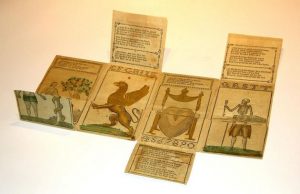 The last, plenary session of the day had four papers. Sophie Defrance, from the University Library, discussed the blurred lines between children’s books and children’s toys and games in the library’s collections. Carl F. Miller called attention to the extraordinary power of literary prizes in the children’s book world, and noted that awards of comparable gravitas for ebooks have yet to emerge. Jen Aggleton reported on the responses of young readers to a set of illustrated novels, charting the process by which these 9/10-year-olds were awakened to the aesthetic pleasures of a well-crafted book. And Zoe Jaques took us deeper into the borderland between books and toys, where a variety of book-like ‘scriptive things’ create severe problems both of categorisation and of shelving.
The last, plenary session of the day had four papers. Sophie Defrance, from the University Library, discussed the blurred lines between children’s books and children’s toys and games in the library’s collections. Carl F. Miller called attention to the extraordinary power of literary prizes in the children’s book world, and noted that awards of comparable gravitas for ebooks have yet to emerge. Jen Aggleton reported on the responses of young readers to a set of illustrated novels, charting the process by which these 9/10-year-olds were awakened to the aesthetic pleasures of a well-crafted book. And Zoe Jaques took us deeper into the borderland between books and toys, where a variety of book-like ‘scriptive things’ create severe problems both of categorisation and of shelving.
Proceedings were wrapped up with a round-table, which offered an opportunity for broader reflection on the category of the scriptive thing and on the seeming self-containment of the book. For me, the day came neatly full circle, sending me back to the opening meditation on Harold and the Purple Crayon, which had revealed above all the extraordinary artfulness of the book’s construction. Modern children’s books, following Harold, are often triumphs of choreography, in which text and image work interact in very sophisticated ways. They are masterful in their handling of gaps and silences, teasing the child reader to make the necessary inferences (often with prompting from a nearby adult). And they constantly reinvent the book, offering new shapes and sizes and graphic conventions so as to pitch readers into weird and unpredictable worlds. It struck me that one of the reasons that we feel so nostalgic about children’s books is because they are so literary. They offer an intense foretaste of grown-up poems, plays and novels, in which the rules of the game are often similarly unclear, and the outcomes deliciously unpredictable.
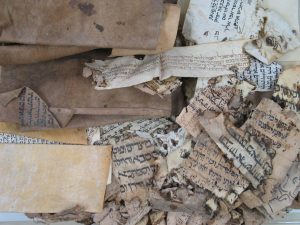 A new exhibition opens at Cambridge University Library today. ‘Discarded History: The Genizah of Medieval Cairo’ puts on show just a few of the 200,000 manuscripts found in the Ben Ezra Synagogue in Cairo in the late nineteenth-century. These were books and documents of all kinds that were no longer needed, but which could not be destroyed because they bore the holy name of God.
A new exhibition opens at Cambridge University Library today. ‘Discarded History: The Genizah of Medieval Cairo’ puts on show just a few of the 200,000 manuscripts found in the Ben Ezra Synagogue in Cairo in the late nineteenth-century. These were books and documents of all kinds that were no longer needed, but which could not be destroyed because they bore the holy name of God.
Conserving these fragments, many of which were ‘literally ground to dust’ in the crush of a single chamber (the Genizah) of the Synagogue, has been a major effort for the library in recent decades. Making sense of such an enormous and multifarious collection has proved just as difficult. Launching the exhibition, Ben Outhwaite said that the curators could have tried to dazzle spectators with ‘the first x’ and ‘the most important y’, but instead they went for a subtler approach, showing how this treasure haul of documents sheds light on the richly multicultural life of an ancient city.
The variety of materials is extraordinary: good-luck charms, prenuptial agreements, alphabet primers, first-hand accounts of earthquakes, and numerous letters–from a refugee, a woman with leprosy, the head of the Jerusalem Academy. There is Moses Maimonides’ treatise on aphrodisiacs (‘if ox-tongue is placed in wine until its strength is extracted, it greatly increases the joy and strengthens sexual intercourse’). There’s a trousseau list including ‘a pen-box made in China’ and a lavish collection of robes and wimples. And there’s one letter in which a woman threatens to go on a hunger strike (in the daytime, at least) if her husband doesn’t come back home full-time, rather than only turning up on the Sabbath. He writes on the back: ‘If you don’t break your fast, I won’t come back Sabbaths or any other day!’ In its charming and its less-than-charming details, it’s an absorbing display.
Book-smells are in the news again. Some doughty chemists and heritage scientists at UCL have teamed up to produce a ‘historic book odour wheel’ that links the perceived scent of old books with their chemical olfactory triggers. So, for example, if you think your book smells of chocolate, that’s probably because it’s giving off vanillin, benzaldehyde and furfural, chemicals that are emitted as the cellulose and lignin in paper degrades. The researchers claim that they are shedding light on how libraries communicate through smell, putting the science together with cultural history to explore the elusive linguistics of scent.
This is just one of innumerable projects in which humanists and scientists are currently getting together to explore the history that lies hidden in old books (Cambridge’s own MINIARE is an excellent example of the genre). It can’t be long before we will be able to subject every book to a full body scan, reconstructing its entire history from its chemical composition. But to focus on scent is also to bring in the imponderables of the human relationship to matter, and all of the cultural variables that cannot simply be read off the physical details.
That much is clear from the comments thread at the bottom of the Guardian report on the research, in which scores of people come forward to confess their love or hate for particular old book-smells. The annuals that children cracked open at Christmas smelled lovely, it seems, while school textbooks usually smelled foul. Kindles are repeatedly faulted for their failure to smell. And the smellscapes of particular bookshops and libraries are fondly recalled. Inevitably there are plenty of parodic contributions, with regular allusions to Proust. But perhaps we are a little bit closer to understanding what the nose knows.
The writer Arundhati Roy was the guest on Desert Island Discs this week. The presenter asked her whether it was true that she was granted complete control over the appearance of her bestselling debut novel The God of Small Things. ‘Granted?–I insisted on it!’ she began; ‘I was just a stubborn thing’. Her publishers had asked her what she would like from them. Her answer: ‘Complete design control: no saris, no tigers on my cover!’
Her comments resonated for me with those of another writer, Jhumpa Lahiri, who recently published an essay entitled The Clothing of Books. The clothing of books means their covers, and for Lahiri the cover brings with it a social anxiety that recalls the anguish she felt as a child caught between the clothing styles of her American schoolfriends and her Bengali parents. On becoming a writer, ‘I discovered that another part of me had to be dressed and presented to the world. But what is wrapped around my words–my book covers–is not of my choosing’.
Lahiri writes movingly about the strange sense of alienation from her own creativity that the cover sets in train. Designed by somebody else, suggesting a reading of the book and a projection of its meaning out into the world, a cover gives a book a new personality and makes it something of a stranger to its author. Lahiri yearns to have the book naked, without all the paratextual elements (author-mugshots, blurbs, snippets from reviews) with which we are now deluged. ‘I want the first words read by the reader of my book to be written by me’.
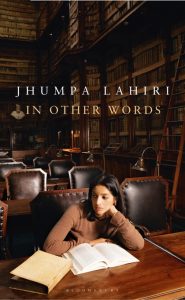 Lahiri cares so much about her books because she feels them to be, in some sense, part of her. A recent autobiographical work, In Other Words, has her photo on the cover, and this is fitting: ‘In the end the author is the book’. When she asks herself to imagine her ideal cover, it is a reproduction of a still life by Morandi or a collage by Matisse. Having written this thought down, she find herself the very next day, coming out of a building, confronted by posters of Morandi to her right and Matisse to her left. For a few moments she imagines herself ‘transformed into the pages of a book’. Some demand complete design control; others have it thrust upon them.
Lahiri cares so much about her books because she feels them to be, in some sense, part of her. A recent autobiographical work, In Other Words, has her photo on the cover, and this is fitting: ‘In the end the author is the book’. When she asks herself to imagine her ideal cover, it is a reproduction of a still life by Morandi or a collage by Matisse. Having written this thought down, she find herself the very next day, coming out of a building, confronted by posters of Morandi to her right and Matisse to her left. For a few moments she imagines herself ‘transformed into the pages of a book’. Some demand complete design control; others have it thrust upon them.
Ben Jonson’s 1624 masque Neptune’s Triumph for the Return of Albion opens with ‘The Poet, entering on the stage to disperse the argument’. The Spanish Tragedy shows Hieronymo presenting the King with a ‘Copie of the Play’ and an ‘Argument of that they show’ before the performance of Solyman and Perseda. Nowadays we might refer to such synopses or summaries distributed to the audience as ‘programmes’. As they are today, programmes would have been useful during performances for their explanation of the masques’ action and symbolism, and as records or tokens of the performance.
Manuscript summaries of speeches and devices were already being distributed in the late sixteenth century at Elizabethan tilts. Philip Gawdy wrote to his father on 24 November 1587, enclosing ‘ij small books for a token, the one of them was given me that day that they ran at tilt’. Roy Strong draws attention to a Revels account payment ‘for the fair writing of all the devices on the 17 day of November … in two copies for the Queen’.
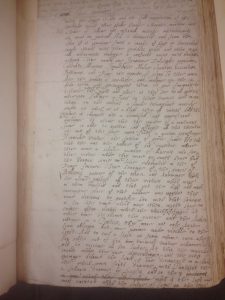
Synopsis of Ben Jonson’s The Masque of Queenes, in BL Harley MS 6947, fol. 143r. By permission of the British Library.
Do any programmes survive from masque performances? Some extant manuscript summaries of masques may have their roots in these elusive books. For example, the summary of Carew’s Coelum Britannicum (1634) now found in BL Harley MS 4931 goes to greater lengths than the printed edition to clarify the masque’s symbolism. It would be easy, however, to confuse these ‘programmes’ with summaries produced for other reasons, such as post-performance accounts, or pre-performance plot proposals for the Court. The summary of Jonson’s Masque of Queenes (1609) now in BL Harley MS 6947, for example, which contains different names for two of the characters, is more likely to have been written for the Court’s inspection before the performance, than copied from a masque programme.
The book which most fits the bill is an undated printed quarto attributed to Aurelian Townshend called The Ante-Masques which, as Karen Britland has recently demonstrated using the evidence of broken type, was printed by Felix Kingston for an entertainment at Oatlands House in August 1635. This quarto summarises the entertainment, including verses from the anti-masques and a ‘Subiect of the Masque’, which explains the masque’s proceedings.
Masques have long been understood as multimedia experiences, incorporating music, gesture, language, stage design and dance. These references to performance programmes reveal that the printed or written page could have also been a part of this experience, and may have been consulted for further information, clarification, or as a record of an ephemeral performance. Unfortunately, these programmes appear to have also lived ephemeral lives themselves.
‘Provide to be sent too morrow in the Cart some Greenfish’
February 2nd, 2017Blog; Jason Scott-Warren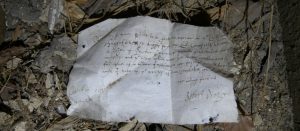 Fascinating to learn last week that three seventeenth-century letters that have been found beneath the floorboards in an attic at Knole House in Kent. The National Trust has reproduced the text of one of the letters, which asks for various goods to be brought from London to a house in Essex:
Fascinating to learn last week that three seventeenth-century letters that have been found beneath the floorboards in an attic at Knole House in Kent. The National Trust has reproduced the text of one of the letters, which asks for various goods to be brought from London to a house in Essex:
Mr Bilby, I pray p[ro]vide to be sent too morrow in ye Cart some Greenfish, The Lights from my Lady Cranfeild[es] Cham[ber] 2 dozen of Pewter spoon[es]: one greate fireshovell for ye nursery; and ye o[t]hers which were sent to be exchanged for some of a better fashion, a new frying pan together with a note of ye prises of such Commoditie for ye rest.
Your loving friend
Robert Draper
Octobre 1633
Copthall
The Trust knows exactly how this letter came to Knole, since ‘my Lady Cranfeilde’ married Richard Sackville, Earl of Dorset, in 1637, and there are documents showing that trunks full of linen, items of furniture and collections of papers were transferred from Copt Hall to Knole in the early eighteenth century.
What I like about the letter is that, both in its contents and in its later history, it is all about the transfer of stuff–the constant, pleasurable yet headache-inducing exchanges that we have with the things in our lives. I also love those ‘greenfish’. The term refers simply to fresh, unsalted fish, but one can’t help wondering whether they weren’t a bit off-colour when they arrived in the cart.
 Last Tuesday, a gaggle of CMT members were treated to a guided tour of the Fitzwilliam’s ‘Colour’ exhibition by the curator, Stella Panayotova. Entering the dimly-lit space and seeing the greens, reds and blues that surround the meeting of Adam and Eve in the Garden of Eden would be a sublime experience in anyone’s book. But this exhibition is really about the meeting of art and science, and in particular the use of modern non-invasive methods to work out which pigments were used in each image. Part of the reason why this image was heading up the show was that it turned out to be concealing instructions for its own colouring. Like a painting-by-numbers, particular areas had written instructions for the colours to be employed in them. And while the manuscript is Parisian, the instructions were in Dutch, which tells you something about flows of expertise around the time of the illumination in 1414.
Last Tuesday, a gaggle of CMT members were treated to a guided tour of the Fitzwilliam’s ‘Colour’ exhibition by the curator, Stella Panayotova. Entering the dimly-lit space and seeing the greens, reds and blues that surround the meeting of Adam and Eve in the Garden of Eden would be a sublime experience in anyone’s book. But this exhibition is really about the meeting of art and science, and in particular the use of modern non-invasive methods to work out which pigments were used in each image. Part of the reason why this image was heading up the show was that it turned out to be concealing instructions for its own colouring. Like a painting-by-numbers, particular areas had written instructions for the colours to be employed in them. And while the manuscript is Parisian, the instructions were in Dutch, which tells you something about flows of expertise around the time of the illumination in 1414.
Such migrations of artists and materials are at the heart of the exhibition. Precious substances travelled thousands of miles along the silk road to be ground up and used in pigments; techniques such as the application of egg yolk to lend sheen to a surface migrated (perhaps) from panel painting to manuscript illumination; identifying particular rare materials in a manuscript can be used to solve mysteries about a manuscript’s provenance, to place or displace it. (The presence of smalt from ground glass in a manuscript by the ‘Murano Master’ appears to confirm that he did indeed work in that centre of glass production, however much the stylistic evidence might tell against this).
Part of the point of the exhibition is to show that a vast amount of medieval painting, particularly from northern Europe, survives between the covers of books. But this overlap between the bookish and the visual has had unfortunate consequences, since over the years many manuscripts have been broken up and mounted as wall-paintings, for display in frames. ‘Colour’ reunites a number of these scattered fragments to see what can be learnt from them, and pulls together the work of researchers at a number of institutes devoted to exploring the chemistry of manuscripts. It’s a wonderful example of what can be achieved by crossing borders, and a tribute to Stella’s infectious enthusiasm for her subject.
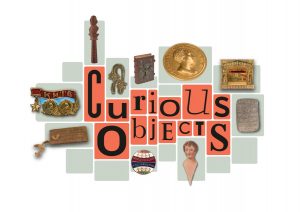 The new Cambridge University Library exhibition opens today. Entitled ‘Curious Objects’, it’s a fascinating display of some of the things that the library accumulated, mostly in a period before the strict demarcation between libraries (for books) and museums (for objects) had kicked in.
The new Cambridge University Library exhibition opens today. Entitled ‘Curious Objects’, it’s a fascinating display of some of the things that the library accumulated, mostly in a period before the strict demarcation between libraries (for books) and museums (for objects) had kicked in.
Among the curiouser articles on display is a leather boot from Lithuania, which was presented to the library along with a shoe and a copy of the New Testament in Lithuanian by the widow of the translator, Tomasz Ramsaeus. Quite why she thought the library needed this footwear is not fully explained. There is also a ‘luminous trumpet’ or spirit trumpet, for use in a séance, together with some ectoplasm in the form of a ‘cloth-like substance’ (which appears to the untrained eye merely to be cloth). ‘This example was captured during a séance given by the medium Helen Duncan and is part of the archive of the Society for Psychical Research’.
For devotees of literature like me, there’s a tobacco stopper made of wood from the mulberry tree supposedly planted by Shakespeare at New Place in Stratford. The catalogue tells us that the tree was cut down by the Reverend Francis Gastrell in the 1750s because he had ‘grown tired of tourists asking to see it’. (That’s one solution to the blight of tourism). Souvenirs made from Shakespeare’s mulberry were apparently commonplace in later eighteenth-century England. A neighbouring cabinet has a beautiful silk bookmark with thirteen strings, each woven with a verse from a medieval Latin prayer to Jesus.
Those of us who suspect that the theory of evolution would not have been formulated had it not been for the proliferation of facial hair in Victorian England will have their views confirmed by another item in the exhibition: a set of cuttings from the beard and whiskers of Frank Chance, who considered himself an exception to Darwin’s rule that ‘when in man the beard differs in colour from the hair of the head … it is … invariably of a lighter tint’, and who wrote to Darwin (with enclosures) to tell him so.
Stone-age tools from Nigeria, wall-paintings from Pompeii, children’s games from Paris, slippers from South India, oracle-bones from Sumatra, spear-heads from Western Australia: there is a whole world of stuff in there. Go see!
Two lovely news stories about non-reading this weekend. The first was about how scientists have discovered that you can use terahertz radiation (a band of radiation between microwaves and infrared) to read closed books, to a depth of nine pages. The technology is facilitated by the fact that the pages of a book trap a pocket of air that is twenty microns deep (one-fifth of the thickness of the average human hair). The bending of the rays allows you to distinguish the signals from different pages and to reconstruct the writing on them. Possible applications include: reading letters without opening the envelopes, and reading books that are too fragile to open.
The second story really relates to what literary critics call ‘distant reading’, rather than non-reading. Two intrepid book-scanners have come up with an algorithm for a bestseller. Advance press reports of what exactly the algorithm shows are rather contradictory. Having scanned 5,000 (or 20,000) books, it can pick out future bestsellers with 80% accuracy. Bestsellers address ‘topics grounded in reality, like marriage, love and crime’ rather than making up fantasy worlds. Bestsellers confine themselves to two topics, such as ‘work’ and ‘human closeness’ (or ‘children and guns’, or ‘love and vampires’–vampires being grounded in reality, I assume), each of which should take up 30% of the space. Bestsellers use the word ‘need’ more than the word ‘want’, and their characters spend their time being rather than seeming. I guess we will have to wait and read the book to make sense of this.
Meanwhile a world where unopened bestsellers are written and read by machines is approaching. We may not notice much of a difference.
